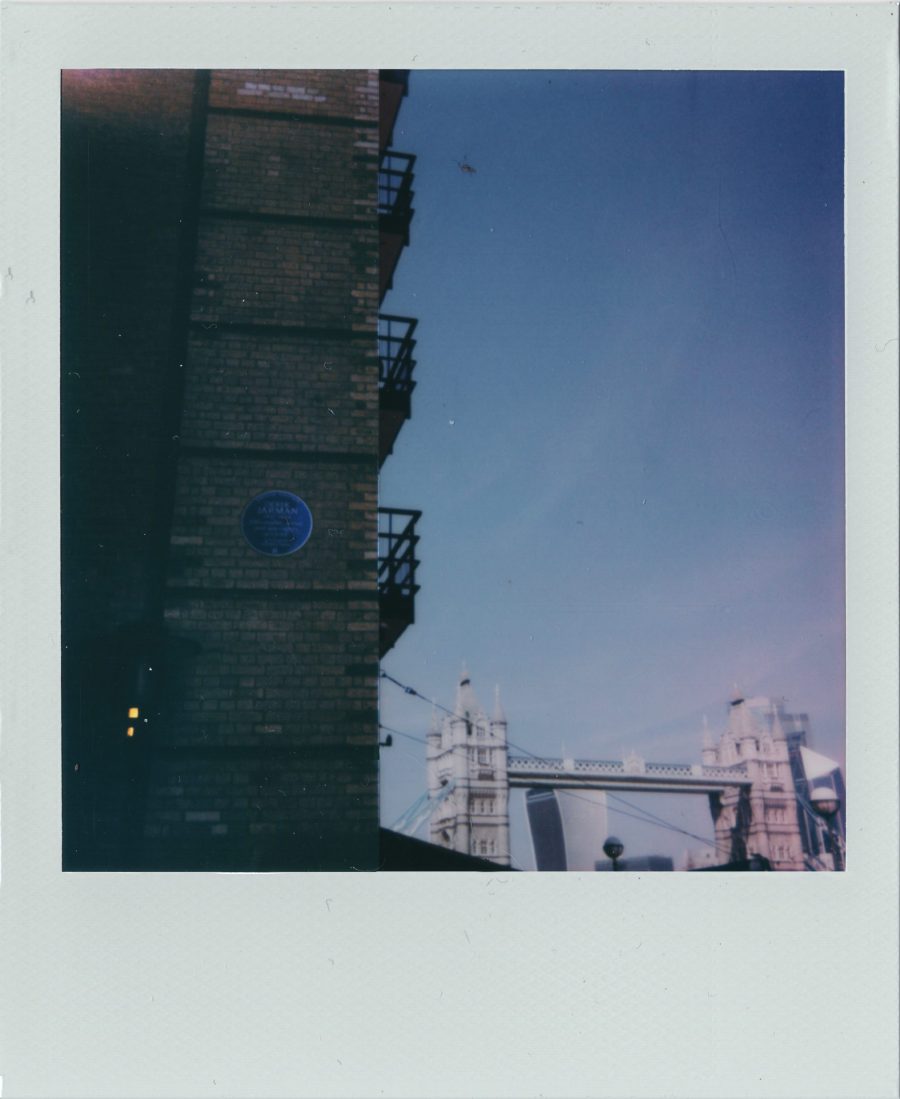Derek Jarman was a wanderer. Though he was associated with a number of places and buildings, in particular the famous Prospect Cottage in Dungeness with its equally celebrated garden, it was really illness that grounded this radical filmmaker, writer and artist on the shingly coast.
Before then, Jarman had made his way through a shabby, derelict London, often using it as a backdrop for his radical reinvention of British cinema. He documented many unique places throughout the 1960s and ’70s before the acceleration of redevelopment and gentrification took over in the ’80s and became the dominant model for urban space in the capital.
Jarman was born 31 January, 1942 in Northwood, which then straddled greater London and the county of Middlesex. His father, Lancelot Elworthy Jarman, was an officer in the Royal Air Force meaning that he and his wife Elizabeth travelled a great deal. They spent time living variously in a range of places from Italy to Pakistan. He went to several schools, including the Canford Boarding School, but finally moved to London in the early 1960s when he began his studies at Kings’ College. Settled is perhaps the wrong word to use, for Jarman was a man who never really settled anywhere until the mid 1980s when he finally found solace in the landscapes of Dungeness.
Like his drifting childhood life, Jarman’s relationship to London was one that was equally in flux. One of his more interesting projects, one that seemed unconsciously undertaken on his part, was his exploration and organic rejuvenation of old industrial spaces, especially those that ran alongside the Thames. In the late ’60s, he moved into a crumbling South Bank house with the artists Peter Logan and Tony Fry.
The pairing with Peter Logan was to prove pivotal to both Jarman’s future work spaces and the general underground arts scene that was to blossom by the river in the following decade. Soon he began his journey following the water, living at 51 Upper Ground with Logan and his sculptor brother Andrew. The parties were legendary though not to last as the building was soon demolished to make way for the South Bank Tower.

Bankside was Jarman’s next stop by Southwark Bridge. It was an important place for Jarman’s work, partly because it was the subject of one his earliest Super-8 films but also because it was famous for its gatherings increasingly centred on film screenings. The room on the top floor became known for housing the director’s bed in a green house, set up to keep the occupants warm in the colder months.
Bankside really witnessed the birth of Jarman’s filmmaking. He even filmed his final wander through the place, simply titled ‘One last walk, One last look, Bankside 1971’, when the building again found itself under the auspices of developers. It would be this move that saw him finally settle for a time in Block A of Butler’s Wharf.
“The area was deserted since the docks had been moved further down the river”, he wrote, “returning home late at night down these empty streets you felt the city belonged to you.” For a time it did, for the wharf was utterly derelict. Artists soon flocked to the new co-operatives created in the various spaces of the wharf, independent artist-led organisations that lived and worked around the spaces, creating new radical alternatives to the more typical gallery spaces; arts of all sorts filling in the post-industrial shells with relish.
The space even acted as a set of sorts. The waste ground outside was used for filming what would become the feature-length project In the Shadow of the Sun, eventually released in 1981 but cut together using super-8 footage filmed there in the early 1970s and soundtracked by Throbbing Gristle.
Jarman would remain in the block until the late 1970s when the developers again continued their march along the Thames and began turning the building into another of their typical luxury pads and offices. Not content to leave in total peace, Jarman used the area in another of his projects: the proto-punk satire Jubilee. If he was going to leave the space to the socially mobile, he was at least going to imbue it with memories of punk anarchists and extreme violence unfolding around St Saviours Dock.
On 19 February, 2019, 25 years after Jarman’s passing, a plaque was unveiled at Butler’s Wharf on the building that housed Jarman’s vast floor studio. In reality, the studio was much higher up on the third floor, boasting envious but ultimately depressing views of the beautiful river and the surrounding buildings as they were gradually remoulded for financiers.
Walking around the area today, it’s unwise to consider how much a flat in the building would cost, never mind one that was the same size as Jarman’s studio. In many ways, the area feels ironically stuck in its own Thatcherite time-warp. It still retains that first bland flavour of gentrification accelerated by Margaret Thatcher’s premiership, the eventual colonisation of spaces like Butler’s Wharf by socially climbing finance workers and businesses catering to their tastes.
The plaque resides as a last rebellious relic, one that celebrates a time when there was still affordable space for artists of all kinds in the centre of the city, from rogue sculptors to pagan punks.
The post Beginnings: Derek Jarman’s Bankside appeared first on Little White Lies.
from Little White Lies https://ift.tt/34wnZQ5
via IFTTT

0 Comments